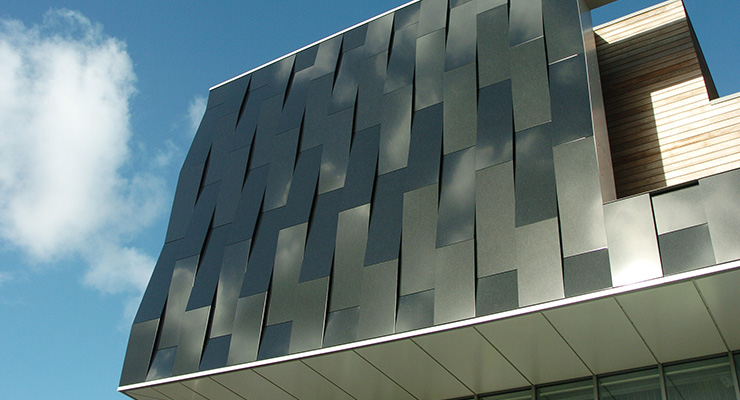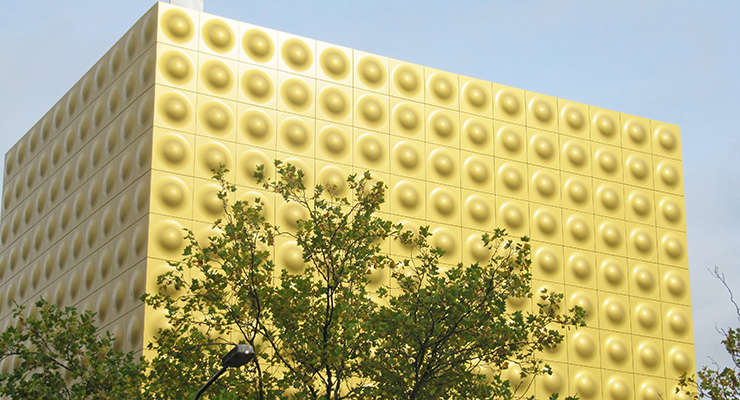David Savastano, Contributing Editor04.11.23
The energy curing market is growing in quite a few industries, but it has been slower to take off in the paint and coatings segment. Much of that is logistical in nature; you can’t really cure architectural paint because of the impossibility of setting up ultraviolet (UV) or electron beam (EB) systems that cover a house, and trying to cure the coatings on a car as it is going through the assembly line would be challenging considering the size and shape of the vehicle.
Still, there are several significant advantages to UV and EB curing. The first is productivity, as UV and EB immediately cure the coating, eliminating drying time. In addition, UV and EB curing can significantly reduce VOC and CO2 emissions and enhance efficiency in the industry by providing up to twice the surface coverage per kilogram of paint.
There have been successful uses of UV and EB in the paint and coatings space. Wood coatings has been a good market for UV. Another market is coil coatings. A specialist in the coil coatings segment, Beckers Group has been developing UV curable coatings for some time.
Recently, Beckers announced that it has developed the first commercial paint formulations for dual ultraviolet and electron-beam curing in the coil coating market. Beckers and one of its long-time customers partnered to develop and test the first ever full-scale application of advanced dual UV/EB curing technology in coil coating for the construction industry. Beckers reports that the first solutions are now in the process of gearing up to go to market.
There is more that needs to happen to grow the use of UV and EB. Beckers is working with customers to retrofit or completely replace existing lines. There is also the need to continue R&D, which Beckers is doing in adding a new two-story purpose-built
Sustainable Innovation Centre in Liverpool; Beckers expects the new building to be ready by the end of this year.
Coatings World spoke with Beckers Group CTO Gavin Bown and Eric Fouissac, Beckers’ President, Southern Europe & Africa, who offered their insights into the potential for UV and EB for coil coatings.
Coatings World: What led Beckers to initially look into developing UV/EB curing for coil coatings back in 2005?
Eric Fouissac: Ultraviolet and electron beam technology for paint was already used in the industry (mainly on wood and paper substrates), but the challenge was very high in coil coating because steel and aluminum are not porous substrates. The paint must be flexible to form the panels after application. We immediately saw the advantage of this technology over our current solvent-based thermosetting paints. Thanks to a very short curing time, UV/EB allows us to increase the speed of the lines at our customers, plus reduce energy consumption and create solvent-free paints. Back in 2005, sustainability was not a key priority for most industries, but it was already an important driver and a clear target for Beckers.
Coatings World: Are UV and EB curing technologies prevalent in the coil coatings market?
Eric Fouissac: Although EB curing has been used in the coil coating industry for several years for the packaging industry, UV/EB curing is brand new for the construction industry. So far only one player has invested and started to use the technology.
Coatings World: What are the major advantages for UV/EB curing for coil coatings?
Gavin Bown: UV/EB cured coil coatings enable the carbon footprint to be reduced by up to 50%, when looked at from Beckers to the coil coater’s factory gate. This is driven by two primary mechanisms. The first is enabling of 100% solids solvent-free formulations, meaning that only approximately 50% of the paint volume is required to achieve the same coverage on metal versus solvent-borne. The second is the big reduction in energy consumption in the coil coating process itself.
Coatings World: This new coating is a dual UV/EB curing technology. How did Beckers come up with this innovative new approach?
Gavin Bown: Innovation often comes about via the reapplication of technology from one industry or segment to another, and this is certainly the case with UV/EB. However, the technology had to be adapted significantly to the requirements of coil coating.
Coatings World: What has been the feedback from your customers?
Eric Fouissac: Now that the technology is performing to the level of solvent-borne coatings, more and more customers are now showing strong interest in the technology, and we have already started several projects.
Coatings World: I see that Beckers is building a new facility in Liverpool dedicated to UV/EB. What led to the decision to add this new facility?
Gavin Bown: Some of the longer-term development concepts for UV/EB will involve the use of equipment requiring a considerable amount of space. With the focus of LTD being primarily on Sustainable Innovation, it therefore seemed like the right time to build a flagship Sustainable Innovation Centre, combining under one roof new UV/EB R&D capabilities with other areas of innovation focused on improving the sustainability of Beckers products.
Coatings World: Are there other areas in the industrial coatings sector where UV/EB can be utilized?
Eric Fouissac: This technology is already used in other areas of industrial coatings. Regarding coil coating, our first target is the construction market, but we are also working on the development of UV/EB paints for other markets such as industry (e.g., roller shutters) and also for domestic appliances.
Coatings World: Do you see a lot of growth ahead for UV/EB in coil coatings?
Gavin Bown: Yes, we are convinced that this technology is the best for the future of coil coating. The European Coil Coating Association (ECCA) came to a similar conclusion during its “Zero Carbon Coil Coating Line” project. But we also know that it will take time before all customers and lines are equipped and we can apply this new UV/EB technology everywhere. We need to develop products for our other coil coating markets, but it is clear that this technology is a powerful answer to the sustainability challenges we face, with clear benefits for the planet.
Still, there are several significant advantages to UV and EB curing. The first is productivity, as UV and EB immediately cure the coating, eliminating drying time. In addition, UV and EB curing can significantly reduce VOC and CO2 emissions and enhance efficiency in the industry by providing up to twice the surface coverage per kilogram of paint.
There have been successful uses of UV and EB in the paint and coatings space. Wood coatings has been a good market for UV. Another market is coil coatings. A specialist in the coil coatings segment, Beckers Group has been developing UV curable coatings for some time.
Recently, Beckers announced that it has developed the first commercial paint formulations for dual ultraviolet and electron-beam curing in the coil coating market. Beckers and one of its long-time customers partnered to develop and test the first ever full-scale application of advanced dual UV/EB curing technology in coil coating for the construction industry. Beckers reports that the first solutions are now in the process of gearing up to go to market.
There is more that needs to happen to grow the use of UV and EB. Beckers is working with customers to retrofit or completely replace existing lines. There is also the need to continue R&D, which Beckers is doing in adding a new two-story purpose-built
Sustainable Innovation Centre in Liverpool; Beckers expects the new building to be ready by the end of this year.
Coatings World spoke with Beckers Group CTO Gavin Bown and Eric Fouissac, Beckers’ President, Southern Europe & Africa, who offered their insights into the potential for UV and EB for coil coatings.
Coatings World: What led Beckers to initially look into developing UV/EB curing for coil coatings back in 2005?
Eric Fouissac: Ultraviolet and electron beam technology for paint was already used in the industry (mainly on wood and paper substrates), but the challenge was very high in coil coating because steel and aluminum are not porous substrates. The paint must be flexible to form the panels after application. We immediately saw the advantage of this technology over our current solvent-based thermosetting paints. Thanks to a very short curing time, UV/EB allows us to increase the speed of the lines at our customers, plus reduce energy consumption and create solvent-free paints. Back in 2005, sustainability was not a key priority for most industries, but it was already an important driver and a clear target for Beckers.
Coatings World: Are UV and EB curing technologies prevalent in the coil coatings market?
Eric Fouissac: Although EB curing has been used in the coil coating industry for several years for the packaging industry, UV/EB curing is brand new for the construction industry. So far only one player has invested and started to use the technology.
Coatings World: What are the major advantages for UV/EB curing for coil coatings?
Gavin Bown: UV/EB cured coil coatings enable the carbon footprint to be reduced by up to 50%, when looked at from Beckers to the coil coater’s factory gate. This is driven by two primary mechanisms. The first is enabling of 100% solids solvent-free formulations, meaning that only approximately 50% of the paint volume is required to achieve the same coverage on metal versus solvent-borne. The second is the big reduction in energy consumption in the coil coating process itself.
Coatings World: This new coating is a dual UV/EB curing technology. How did Beckers come up with this innovative new approach?
Gavin Bown: Innovation often comes about via the reapplication of technology from one industry or segment to another, and this is certainly the case with UV/EB. However, the technology had to be adapted significantly to the requirements of coil coating.
Coatings World: What has been the feedback from your customers?
Eric Fouissac: Now that the technology is performing to the level of solvent-borne coatings, more and more customers are now showing strong interest in the technology, and we have already started several projects.
Coatings World: I see that Beckers is building a new facility in Liverpool dedicated to UV/EB. What led to the decision to add this new facility?
Gavin Bown: Some of the longer-term development concepts for UV/EB will involve the use of equipment requiring a considerable amount of space. With the focus of LTD being primarily on Sustainable Innovation, it therefore seemed like the right time to build a flagship Sustainable Innovation Centre, combining under one roof new UV/EB R&D capabilities with other areas of innovation focused on improving the sustainability of Beckers products.
Coatings World: Are there other areas in the industrial coatings sector where UV/EB can be utilized?
Eric Fouissac: This technology is already used in other areas of industrial coatings. Regarding coil coating, our first target is the construction market, but we are also working on the development of UV/EB paints for other markets such as industry (e.g., roller shutters) and also for domestic appliances.
Coatings World: Do you see a lot of growth ahead for UV/EB in coil coatings?
Gavin Bown: Yes, we are convinced that this technology is the best for the future of coil coating. The European Coil Coating Association (ECCA) came to a similar conclusion during its “Zero Carbon Coil Coating Line” project. But we also know that it will take time before all customers and lines are equipped and we can apply this new UV/EB technology everywhere. We need to develop products for our other coil coating markets, but it is clear that this technology is a powerful answer to the sustainability challenges we face, with clear benefits for the planet.
















